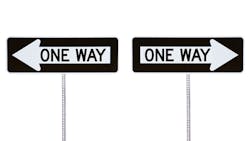A Tale of Two Improvement Strategies: Tactical vs. Strategic
This article will outline and differentiate between the two primary approaches to increasing work efficiency. The discussion will start with a general focus on the topic and then at the end tie-in to Next Generation Supply Management.
Relative to work, “tactical” is a term used to describe the actions that support day-to-day operations. For instance, purchase orders ensure the steady inflow of the goods and services required to support manufacturing. Processing and loading purchase orders, then, would be considered a tactical work activity.
Tactical work is the basis of operational effectiveness since it produces the impacts that are measured in evaluating performance. Because of this, changes in tactical efficiency are used to measure whether individual or departmental performance is improving or degrading.
Most improvements to tactical efficiency are incremental. This means that in the big scheme of things, incremental changes have a minimal impact on performance improvement. For instance, if a buyer is expected to be able to process and load 40 purchase orders a week, implementing a process change that raises the average output up to 41 a week—a 2.5% productivity increase—is considered incremental. Buyers who complete more than the departmental weekly average, then, are generally seen as “high performers”—at least in this one area—and are rewarded through performance management.
The term “strategic,” on the other hand, is used to refer to actions that, while they are not integral to day-to-day operations, have the potential to significantly improve the efficiency of tactical work by delivering step-function magnitude efficiency impacts. Reducing the need for buyer involvement in the processing and loading of purchase orders such that average weekly buyer output increases to 80 per week would be a step-function level improvement.
Incremental improvements are important in business but certainly can’t be the sole basis for achieving (or maintaining) world-class performance. The same can be said for employees who remain constrained within existing processes in their efforts to exceed productivity norms. While such employees may become super-skilled in performing specific tasks, they do not change the essence of the work and so cannot deliver step-function magnitude performance improvement impacts.
Incremental positive impacts will always be overshadowed by strategic improvements, whether they are made within your company or by a competitor. For instance, doubling the rate at which purchase orders can be processed and loaded represents years of traditional incremental efficiency improvement effort. Consequently, shouldn’t management delegate at least a portion of their change management resources towards trying to achieve step-function process improvements? Of course it should. In reality, though, too many focus almost exclusively on delivering incremental changes.
Why is this? Mainly because incremental improvements can be predictably delivered and step-function improvements cannot. Most managers tend to focus on “sure bets,” counting on the accrual of enough incremental improvements to move the productivity meter sufficiently that their bosses’ expectations are met. To have a chance at differentiating their performance improvement from that of other departments, many managers feel they need to focus every available bit of process improvement resources on those that can be predictably delivered, or they’ll be out-performed. They know achieving step-function improvements would be nice but if efforts at attaining them don’t pan out over time they don’t want to be left looking bad compared to their peers. No manager wants that. Even so, you might ask, “What’s so bad about an incremental improvement approach?” After all, the tortoise did beat the hare, didn’t he? Let me explain.
It's Better When You're the Game-Changer
Even if you are competitive today, relying on incremental improvements will not necessarily keep you competitive going forward. When China changed the rules of industrial competition in the 1990s, there were a lot of companies that went out of business because the incremental improvement strategies that had made them successful in the past weren’t sufficient to counter-balance the changes China brought to the manufacturing landscape.
Granted, factors like the emergence of China as a force in manufacturing do not occur very often. But if you run your business hoping that a strategy of incremental improvements will keep you competitive you need to understand that sooner or later some sort of “game changer” will be introduced in your industry that will severely threaten your company’s competitiveness. Wouldn’t you rather be the one introducing that “game changer?”
In spite of understanding this, many managers still focus their process efforts almost exclusively on pursuit of incremental improvements. The reason is that under current performance management, managers producing the most incremental improvements are rewarded, even if it is only slightly above that delivered by their peers. Those managers that may want to work on producing longer range step-function type impacts don’t get rewarded unless/until their efforts pay off and, in many organizations today, the payback horizon is so short that such managers may be seen as under-performing and end up not having the opportunity to “stay the course” with their strategic-type initiatives.
So, managers are reluctant to take resources off of activities offering incremental improvement since doing so may affect how their near-term performance is perceived by executive management. And let’s be honest, regardless of how good they may sound when they are proposed, some strategic activities don’t ever live up to hopes or expectations, i.e., higher reward endeavors also usually pose higher risk. Frankly, I’ve never been impressed by—or promoted—employees that did not at some time or another at least try to create step-function efficiency improvements in their jobs. What is needed is a combination of incremental and step-function continuous improvement activities, with the understanding that some of the more strategic ones won’t pay-off but also that some will. And that big-hitters are worth going after because of their potential to change the competitive landscape in your company’s favor. So how do you make this change?
First, expectations of strategic activity need to be introduced into the performance management system. The higher the job level, the higher the expectation should be. For instance, directors and vice-presidents should have an almost exclusive—75% to 90%—focus on strategic work activities while down the food chain (buyers, for instance) that focus should be more in the 15% to 25% range. Compare this to organizations I’m familiar with where executive-level people start out most every day with long “hit lists” of tactical activities they need to address. These executives are very good at taking care of tactical issues, which is one of the reasons they moved up the ladder. Unfortunately, they are rarely able to work their way completely through these lists, leaving no time for strategic activities. Consequently, the performance of their departments and/or company does not improve more than incrementally.
Higher performance ratings should no longer be assigned to employees who outperform their peers only by an incremental amount. Rather, they will be given to those who are either working on strategic projects that have the potential to—or better yet, have delivered—step-function improvement impacts. For instance, if a buyer only processes an average of 36 purchase orders a week—well below average—but other parts of his work was fundamental to reducing a high percentage of the overall purchase orders that need processing—or reducing the amount of processing they need—that’s the type of employee that should be rewarded and promoted. Merely out-performing peers by a few percentage points should no longer deliver the highest ratings. This would be a radical change in most organizations I’m familiar with.
Many managers today reached their positions by being good at either fire-fighting or making incremental improvements. Unfortunately, this has crowded out of leadership positions those who might be more apt to deliver—if given the authority and scope—step-function magnitude improvements. In my mind no-one should be moved into a position of authority without having delivered some level of strategic impact in a lower position. And no-one should receive the highest performance rating without having delivered a high impact strategic result.
Get Out of the Incremental Performance Improvement Rut
If the above makes sense, you might be wondering how it all relates to the supply management function? Here I’ll make a statement that will likely lead to some teeth grinding and possibly some controversy. Namely,
“Supply management departments that measure department performance primarily on impact on piece-price will never get out of the incremental performance improvement rut.”
This means your department/company will never achieve world-class performance, which should be everybody’s goal. Incremental improvements in piece-price will seldom provide real differentiation between you and your competitors. Yet those that have historically delivered the most in terms of incremental piece-price reductions are usually the ones promoted into procurement management. Sure, piece-price improvement can be approached strategically by considering other types of processes—for instance, converting from one type of plastic molding process to another—but in the end a piece-price focus typically only provides incremental benefits.
Procurement’s focusing on piece-price reductions is a lot like a baseball team hoping to win with only singles hitters in the line-up. It can be done but a lot of factors have to fall into place for it to happen. On the other hand, whenever you run into a competitor with more “power”—the ability to deliver step-function improvements—you’ll have a tough time coming out ahead.
Those areas where most step-function type “low-hanging fruit” is to be found are in the factors other than piece-price that make up Total Cost. This is primarily because they have been for the most part neglected. On the other hand, the strict focus on direct piece-price reduction has milked most of the easy money such that further effort has diminishing returns. If you’ve read this column over time, you understand what I mean by this. Do you remember last June’s “Should Procurement have a Seat at the Table?” article? If you haven’t read it, you might want to refer to it.
In my opinion, companies that make piece-price the primary metric of supply management performance are missing the boat relative to making the step-function type improvements in cost that industry leaders deliver. Total Cost impacts have the potential to be grand slam home-runs, when everything lines up right. And even when they do not, a Total Cost focus can deliver a lot of doubles and triples.
My next column will take a lighter approach and discuss how to deal with competing company priorities.
About the Author

Paul Ericksen
Executive Level Consultant; IndustryWeek Supply Chain Advisor
Paul D. Ericksen has 40 years of experience in industry, primarily in supply management at two large original equipment manufacturers. At the second he was chief procurement officer. He then went on to head up a large multi-year supply chain flexibility initiative funded by the U.S. Department of Defense. He presently is an executive level consultant in both manufacturing and supply chain, counting Fortune 100 companies among his clientele. His articles on supply management issues have been published in Industrial Engineering, APICS, Purchasing Today, Target and other periodicals.
